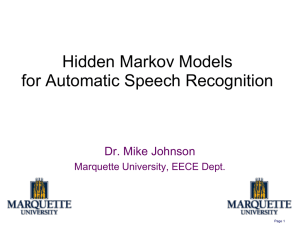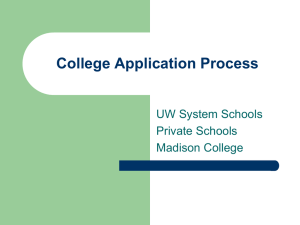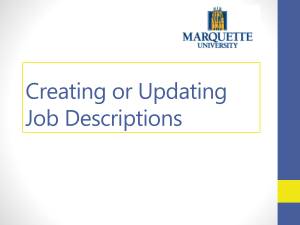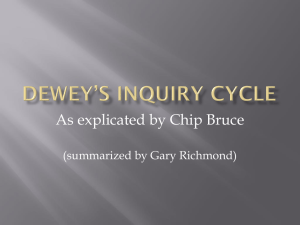CS4Impact: Measuring Computational Thinking Concepts Present in
advertisement
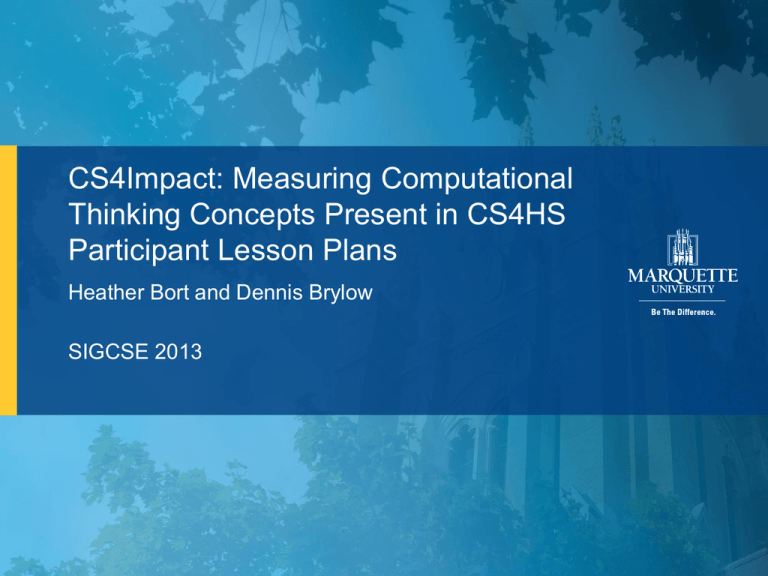
CS4Impact: Measuring Computational Thinking Concepts Present in CS4HS Participant Lesson Plans Heather Bort and Dennis Brylow SIGCSE 2013 Marquette University 1 Outline Problem Solution Workshop Structure Rubric Results Future Work Marquette University 2 The Problem Many current K-12 outreach efforts attempt to increase the number of students interested in majoring in computer science and related fields Assessing these efforts has proven to be challenging Most prior work on examining the impact of professional development interventions for K12 CS teachers stops with indirect measures Marquette University 3 Indirect vs Direct Measuring Knowledge • Before and After workshop attitudinal survey (indirect) • Concept Quiz (direct) Measuring Concept Integration • Surveying attitudes about using the concepts in their classrooms (indirect) • Ability to integrate workshop material into lesson plans for the classroom (direct) Marquette University 4 Measuring Impact Workshop structured around Computational Thinking (CT) lesson plan building and sharing Designed a rubric to measure how CT concepts were used in the lesson plans Applied the rubric during the sharing phase of the workshop Marquette University 5 Workshop Structure A: basic Combined • Exploring CS and CT • Boolean Building Blocks • HPC and Sciences • CT and the Sciences • Alice • Algorithms • Scratch • State and Curriculum Issues • Problem/Project-Based Learning and Computational Thinking • Careers Panel • Google Keynote Marquette University B: advanced • • • • • AP CS Principles Creativity Big Data Scratch Impact and the Internet • TechSpots • Lesson Planning 6 Data Collection Each participant presented their lesson plan to the group Presentations were video taped for later analysis 4 hours video data with full text of written plans coded with rubric Marquette University 7 Rubric Computational Thinking Concepts Level of Inquiry Marquette University 8 Computational Thinking Jeannette Wing states that computational thinking “represents a universally applicable attitude and skill set everyone, not just computer scientists, would be eager to learn and use” a problem solving method that uses algorithmic processes and abstraction to arrive at a answer showcase concepts over programming skill or computational tools in the classroom Marquette University 9 Computational Thinking Concepts Data Collection Data Analysis Data Representation Problem Decomposition Abstraction Algorithms & Procedures Automation Simulation Parallelization Marquette University 10 Why Inquiry based learning? • • • • We learn by inquiry from birth Important skill set Central to science learning Right answer versus appropriate resolution Marquette University 11 Traditional Approach to Learning • • • • • Focused on mastery of content Teacher centered Teacher dispenses “what is known” Students are receivers of information Assessment is focused on the importance of “one right answer” Marquette University 12 Inquiry Approach to Learning • Focused on using and learning content to develop information processing and problem solving skills. • More student centered • Teacher is the facilitator of learning • More emphasis on “how we come to know” • Students are involved in the construction of knowledge Marquette University 13 Sage on the Stage Versus Guide on the Side Marquette University 14 Levels of Inquiry Inquiry Level Question Procedure Solution 1- Confirmation Inquiry Students confirm a principle through an activity when the results are known in advance. X X 2- Structured Inquiry Students investigate a teacherpresented question through a prescribed procedure. X X 3- Guided Inquiry Students investigate a teacherpresented question using student designed/selected procedures. X X 4- Open Inquiry Students investigate questions that are student formulated through student designed/selected procedures. Marquette University 15 5 Characteristics Of Inquiry Based Learning Marquette University 16 1. Bloom’s taxonomy •Inquiry based learning asks questions that come from the higher levels of Bloom’s Taxonomy Marquette University 17 Evaluation Synthesis Analysis Application Comprehension Knowledge Marquette University 18 2. Asks questions that motivate •Inquiry based learning involves questions that are interesting and motivating to students Marquette University 19 Types of questions • • • • • Inference Interpretation Transfer About hypotheses Reflective Marquette University 20 3. Utilizes wide variety of resources •Inquiry based learning utilizes a wide variety of resources so students can gather information and form opinions. Marquette University 21 4. Teacher as facilitator • Teachers play a new role as guide or facilitator Marquette University 22 5. Meaningful products come out of inquiry based learning •Students must be meaningfully engaged in learning activities through interaction with others and worthwhile tasks. Marquette University 23 Inquiry based learning in Computer science • • • • • Cooperative Learning Teamwork Collaboration Project-oriented learning Authentic Focus Marquette University 24 Rubric Concept Data Collection Data Analysis 0 1 2 not incorporated provides the data the the student will use students are required to collect their own data an interpretation of the students will analyze not incorporated data is given to the the data student the student is given a Data Representation not incorporated specific method to use Problem Decomposition Abstraction Marquette University students are able to choose their own method students are an outline or similar required to break the not incorporated structure is provided to problem down on the student their own not incorporated provides an expected student arrives at an outcome outcome 25 Rubric Concept 0 1 2 not incorporated the basic steps for an algorithmic solution are provided students develop an algorithm or procedure not incorporated students are provided with a program or some other technology that automates their process students are able to automate their process Parallelization not incorporated students will decide students are instructed how to distribute their to work in parellel workload Simulation not incorporated Algorithms and Procedures Automation Connecton to Other Fields Marquette University not incorporated students are shown a simulation students will produce their own simulation students are required the connection is given to make a connection to the student to another field26 Results Concept 0 1 2 Data Collection 7 6 3 Data Analysis 9 4 3 Data Representation 8 6 2 Problem Decomposition 5 10 1 Abstraction 5 9 2 Algorithms and Procedures 4 9 3 Automation 3 12 1 Parallelization 12 2 2 Simulation 0 13 3 Connection to Other Fields 10 6 0 Marquette University 27 What We Learned Many of the participants did not effectively integrate the CT core concepts into their lessons A large number of lesson plans scored 0 in some sections of the rubric Marquette University 28 What We Learned Among the experienced CS teachers, some are firmly entrenched in a pedagogical style that still emphasizes conveying facts and programming language syntax, not in focusing on skill building Large number of participants were able to produce lesson plans with level 1 or level 2 components, sometimes in multiple core areas. Marquette University 29 Follow Up One third of participants volunteered feedback for six month follow up survey. All but one respondent has been incorporating concepts from the workshop in their classrooms Marquette University 30 Moving Forward Link CS4HS content to Common Core Standards Better lesson plan development and assessment Continued multi track structure Marquette University 31 Our Thanks To: Google Wisconsin Department of Public Instruction The Leadership of the Wisconsin Dairyland CSTA The many teachers that participated Marquette University 32



